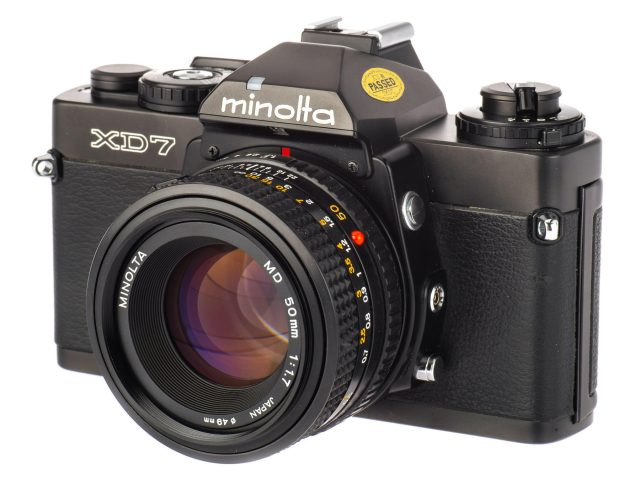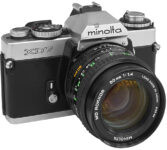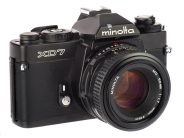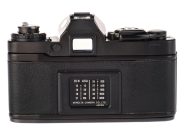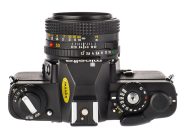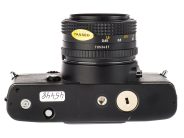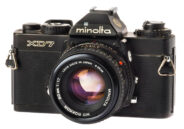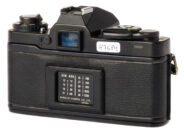Announced
Production status
System
Minolta SR system cameras
- Minolta SR-1
- Minolta SR-1s
- Minolta SR-2
- Minolta SR-3
- Minolta SR-7
- Minolta SRM
- Minolta SRT100
- Minolta SRT101
- Minolta SRT102
- Minolta SRT200
- Minolta SRT200 (II)
- Minolta SRT201
- Minolta SRT201 (II)
- Minolta SRT202
- Minolta SRT202 (II)
- Minolta SRTMC
- Minolta SRTMC-II
- Minolta SRTSC
- Minolta SRTSC-II
- Minolta X-370
- Minolta X-370N
- Minolta X-370s
- Minolta X-570
- Minolta X-600
- Minolta X-7
- Minolta X-700
- Minolta X-7A
- Minolta X-9
- Minolta XD-S
- Minolta XD11
- Minolta XD5
- Minolta XE
- Minolta XE-5
- Minolta XG 9
- Minolta XG-1
- Minolta XG-1(n)
- Minolta XG-A
- Minolta XG-M
- Minolta XG-SE
- Minolta XG7
- Minolta XK
- Minolta XK MOTOR
Minolta XD11
aka Minolta XD
aka Minolta XD7
35mm MF film SLR camera • Discontinued
Specification
| Format: | |
| 35mm full frame | |
Film type: | 135 cartridge-loaded film |
| Minolta SR [43.5mm] | |
| Shutter: | |
Type: | Focal-plane |
Model: | Electronically controlled |
Speeds: | 1 - 1/1000 + B |
| Exposure: | |
Exposure metering: | Through-the-lens (TTL), open-aperture |
Exposure modes: | Aperture-priority Auto |
| Shutter-priority Auto | |
| Manual | |
| Physical characteristics: | |
Weight: | 560g |
Dimensions: | 136x86x51mm |
Manufacturer description #1
A compact 35mm SLR so advanced that it can actually correct exposure errors, even if you fail to.
Tomorrow's camera is here: a 35mm SLR so infinitely versatile that it will change the way you take pictures.
Multi-mode creative control.
No longer must you choose between aperture-priority or shutter-priority automation. The Minolta XD-11 gives you both, as well as fully manual operation.
The aperture-priority mode gives you control over depth-of-field and lets you use close-up equipment or mirror lenses automatically. As you adjust the aperture, the XD-11 sets the precise shutter speed needed for correct exposure, steplessly from 1 to 1/1000th second.
When shutter speed control is more important, use the shutter-priority mode. The XD-11 will set the aperture automatically.
In both automatic modes, an override lets you modify exposure up to ±2 EV in click stops or continuously.
And you can have full manual control, setting both aperture and shutter speed as you wish. In manual mode, the metering system continues to give you exposure information.
Electronic exposure automation. And then some.
Electronics are at the heart of the XD-11, monitoring and adjusting exposure with infinite precision and providing a continuous LED viewfinder display of camera and light conditions.
Even if you fail to heed LED over- or under-exposure warnings during shutter-priority operation, the XD-11 will - on its own - automatically adjust speeds within the range of the shutter to provide correct exposure.
Although the XD-11 is electronic, you're not totally at the mercy of battery power. If batteries fail, you may still take a picture on "B" or at "O," which is 1/100th second.
No other 35mm SLR viewfinder is as bright.
The light-gathering power of over two million tiny conical lenses makes the XD-11's viewfinder the brightest of all 35mm SLR cameras. Composing and focusing are fast and effortless, even in the dimmest light and along the edges of the finder.
The instant-return mirror is the largest in any 35mm SLR. Result: no image cut-off in the finder with even the longest lenses.
The finder stays at full brightness, but exposure is measured through the taking aperture.
The XD-11's meter reading is center weighted for optimum exposure accuracy under a wide variety of light conditions. A silicon photo diode reads light constantly and reacts instantly to changes.
From the moment you release the shutter, the meter begins to measure light coming through the aperture as it is closing. Final measurement is made through the actual taking aperture, even though the finder remains at full brightness up to the very instant of exposure.
Quiet, smooth operation that can't be described.
You have to listen to the XD-11 to believe that any 35mm SLR can be this quiet.
The film advance is silky smooth, without a trace of harshness or grinding. A feather touch on the electromagnetic shutter release brings the XD-11 to life, activating the metering system and viewfinder display. Depress the release and you've made your exposure. Effortlessly and ever so softly, with vibration and sound cushioned by insulation and a specially designed damper mechanism.
The XD-11 is compact, but not cramped. Lightweight, but with a solid, substantial feeling. Your fingers fall into place naturally on oversized controls. The back is contoured to fit your hands. Glove-soft leather-like material cushions the body.
The all-important details.
The XD-11 is filled with all the little refinements that make photography easier and more rewarding. It will give you precisely registered multiple exposures with pushbutton simplicity. There's a window to show when film is advancing properly. A viewfinder curtain to keep light out during tripod or remote operation. A variable self-timer. And a depth-of-field preview button.
Not just another winder.
The optional Auto Winder D for the XD-11 is the smallest and lightest available today. It attaches in seconds, without removing any caps. And you can reload your camera, rewind the film or make multiple exposures without removing it.
The winder will advance the film one frame at a time or continuously at two frames per second. It stops automatically at the end of the film. An LED flashes to show when the winder is operating and glows steadily when the roll is completed.
Not just another electronic flash.
Here's another unusual feature that you should find very useful: an optional electronic flash that can fire in synch with the XD-11's Auto Winder.
The Auto Electroflash 200X attaches to the hot shoe of the XD-11 and automatically sets the shutter for flash synch at 1/100th second when the unit is recycled. A pulsating LED in the viewfinder shows when the Electroflash is ready to fire. Until then, the XD-11 will continue to operate automatically in aperture or shutter-priority mode and the 200X will not fire.
Use any Minolta lens ever made.
If you own MC Rokkor-X, MC Rokkor or Celtic lenses, you'll be glad to know that they can be used without modification on the XD-11 in the aperture-priority and manual modes. A new series of "MD" lenses has been designed for use with the XD-11 in all modes.
Manufacturer description #2
Your light, compact XD-11 camera is the first 35mm single-lens reflex on the market that lets you set either shutter speed or lens aperture according to your photographic purpose, with the camera's computer then automatically and steplessly controlling the other value for proper exposure. You can also set exposure manually, with or without reference to the camera's calculation. If you wish, you can leave exposure control entirely to the camera's program for perfect results over a wide range. Whichever you choose, complete solid-state information in the finder is automatically adjusted to show only that applicable, and a newly developed screen makes viewing brighter and focusing easier and more accurate. Safe Load Signal and electromagnetic shutter release head a host of other features. Attaching the accessory Auto Winder D enables single-frame/continuous motor film advance up to 2 frames/sec. Minolta's special Auto Electroflash signals flash-ready in the finder when charged and electronically sets the XD-11's shutter for strobe exposures when it is released; it also enables continuous-sequence flash with the winder. Besides new MD Rokkor-X lenses, your XD-11 uses virtually all interchangeable Rokkor-Xs made to date and all applicable Minolta SLR system accessories.
Manufacturer description #3
TYPE: Compact 35mm single-lens reflex with shutter- or aperture-priority automatic or metered/full-manual exposure control
LENS MOUNT: Minolta SLR bayonet, 54 deg. rotation angle; coupling for full-aperture metering and finder-display input and automatic diaphragm control, providing shutter-speed priority and aperture-priority operation with MD Rokkor-X lenses, aperture-priority operation only with MC and other Rokkor-X lenses; spring-return button for depth-of-field preview and for stop-down meter readings with other than MC or MD lenses (Standard lenses: 50mm f/1.4 or f/1.7 MD Rokkor-X)
AUTO-EXPOSURE CONTROL: Special low-voltage, low-current computer circuit (incorporating large-scale monolithic and hybrid ICs, samarium-cobalt compound impulse-release magnets and linear-resistance inputs) varies aperture and/or shutter speed steplessly for proper exposure according to metering indication at the shutter-speed/aperture, and film speed, and/or exposure adustment set. Auto-exposure range: EV 1 to EV 18 at ASA 100 with f/1.4 lens
SHUTTER: Vertical-traverse metal-blade focal-plane type, with electromagnetic release; electronically controlled speeds: 1/1000 to 1 sec. steplessly on automatic modes or in steps on manual mode or at "X" (1/100 sec.) setting. Mechanically controlled settings (no battery power required): "O" (1/100 sec.), "B" (bulb)
METERING: TTL center-weighted type by silicon photo cell mounted at rear of pentaprism; at full aperture for normal display, at taking aperture for exposure (shutter-speed) determination or stop-down display
FILM-SPEED RANGE: ASA 12 to 3200 set by dial (around rewind-crank/back-release knob) with lock
AUTO-EXPOSURE ADJUSTMENT: Up to +/-2 EV continuous adjustment of auto or metered manual with locks at zero-position and each EV setting
MIRROR: Oversize quick-return type (PO value: 143mm) with pneumatic damper
VIEWFINDER: Eye-level fixed pentaprism type showing 94% of 24x36mm film-frame area; magnification: 0.87X with 50mm standard lens focused at infinity; power: -1D, variable with accessory snap-on eyepiece correction lenses; Fresnel-field focusing screen having an artificially regular-patterned matte field plus central split-image horizontally oriented focusing spot surrounded by microprism band; visible around frame: Shutter speed and f-number set on "S" or "M" mode, f-number set with MD or most MC lenses on "A" mode; LED indication of aperture (on "S") or shutter speed (on "A" or "M") for correct exposure by 10 light-emitting diodes; LED over-/under-range indicators, upper of which also blinks as a flash-ready signal with Auto Electroflash 200X and lights at "X", "O", and "B" shutter settings; Built-in eyepiece shutter positioned by lever
FLASH SYNC AND CONTROL: PC terminal and hot shoe for X-sync. (disconnected when unit not installed); Electronic flash synchronizes at 1/100 sec. (i.e., electronic "X" or mechanical "O" shutter settings) and slower step or stepless speeds; Class MF, M, and FP flashbulbs synchronizes at 1/15 or slower speeds. Extra contact on hot shoe, receives signal from camera-control contact of Auto Electroflash 200X whenever capacitor is charged to cause upper LED triangle in finder to blink and then set shutter at fixed 1/100 sec.
FILM ADVANCE: Motorized: Through built-in coupler key with accessory Auto Winder D. Manual: By lever with single 130 deg. stroke after 30 deg. unengaged movement. Film advance release button for rewinding and multiple exposures. Advancing-type frame counter (no advance with multiple exposures). Safe Load Signal indicates film loading and advancing condition
POWER: Two 1.5v silver-oxide cells contained in camera base power both auto exposure control and shutter's electronically governed operation. Power switch in operating button. Battery check by depressing operating button slightly: LED's dim or do not light as cells approach exhaustion. Shutter will not release when voltage too low for proper operation
SELF-TIMER: Lever type, operating time variable up to approx. 10 sec. at full stroke; cycle started by pushing operating button
OTHER: 4-slot take-up spool; detachable back cover with memo holder and ASA-DIN conversion scale
